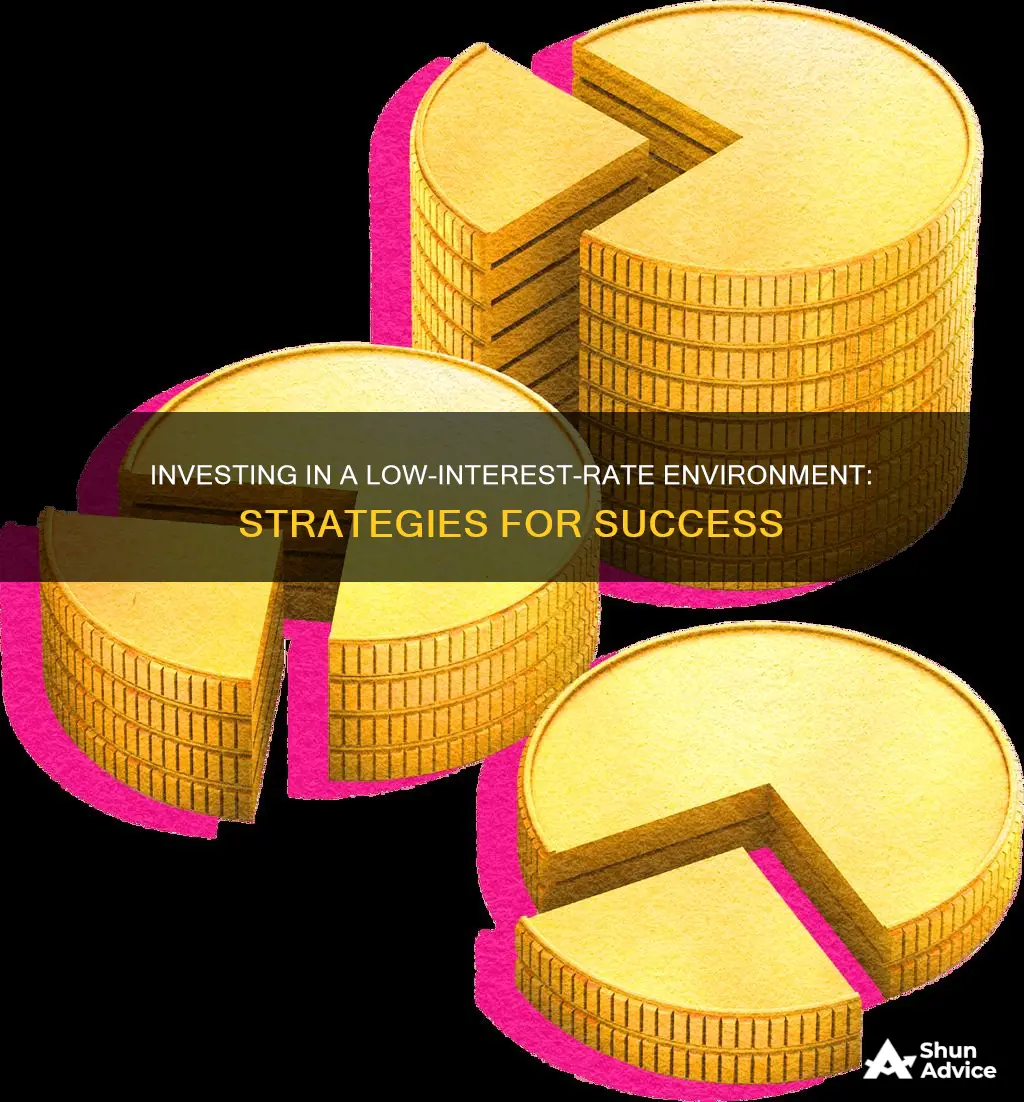
When interest rates fall, investors may be concerned about how this will affect their investments. However, there are several strategies that can be used to make the most of a low-interest-rate environment. For example, investing in stocks, bonds, or property can be a good idea when interest rates are low. This is because lower financing costs can lead to better financial positions for companies, making debt more attractive and potentially strengthening stock prices.
| Characteristics | Values |
|---|---|
| Create a diversified portfolio | Invest in index funds or exchange-traded funds (ETFs) |
| Dividend-paying stocks | Companies that offer dividends often do well as rates fall |
| Consumer defensive stocks | Consumer staples can be attractive in almost any environment since people need to buy them |
| Bonds | Fixed income investments that pay out a set amount of interest, called a coupon |
| Stocks | Lower financing costs lead to better financial positions for companies, making debt more attractive |
| Property market | Lower interest rates encourage people to take out mortgages, purchase goods on credit cards and also reward businesses that use leverage |
| Growth companies | Funds that focus on growth companies, such as technology stocks, have the potential to grow in value when interest rates fall |
What You'll Learn

Dividend-paying stocks
When interest rates are falling, stocks are likely to benefit. Lower financing costs lead to better financial positions for companies, making debt more attractive. Companies might be more willing to invest in their businesses and keep workers around, with increased profitability leading to potentially stronger stock prices.
One type of stock that can be a good investment when interest rates are falling is dividend-paying stocks. Companies that offer dividends often do well as rates fall. Plus, the regular payments can exceed what you’d receive with your money in cash. Some stocks, such as dividend aristocrats, have a yearly history of increasing dividend payouts. Dividend-paying stocks can be a good way to create a diversified portfolio, which can help build wealth over time, regardless of what’s happening with interest rates.
Dividend aristocrats are companies that have increased their dividend payouts each year for at least 25 consecutive years. These companies are often seen as stable and reliable investments, as they have a long track record of paying dividends. Some examples of dividend aristocrats include Coca-Cola, Johnson & Johnson, and Procter & Gamble.
When considering investing in dividend-paying stocks, it's important to keep in mind that not all companies that pay dividends are created equal. It's crucial to research the company's financial health, business model, and future prospects to ensure that the dividend payments are sustainable. Additionally, it's worth noting that dividend-paying stocks may not always be the best investment option, as there are other factors that can impact stock prices, such as market conditions and company-specific news.
Overall, dividend-paying stocks can be a good option for investors seeking income and stability when interest rates are falling. By investing in companies with a strong track record of dividend payments, investors can potentially benefit from regular payments and capital appreciation. However, it's important to conduct thorough research and consider other investment options as well to create a well-diversified portfolio.
Interest Rates: Impacting Investment Strategies and Returns
You may want to see also

Consumer defensive stocks
When interest rates are falling, stocks are likely to benefit. Lower financing costs lead to better financial positions for companies, making debt more attractive. Companies might be more willing to invest in their businesses and keep workers around, with increased profitability leading to potentially stronger stock prices.
Additionally, consumer defensive stocks can be a good investment when interest rates are falling because they are often stable and reliable. These companies tend to have consistent revenue streams and are less likely to be affected by economic downturns. This can make them a good choice for investors who are looking for stability and consistent returns.
Overall, consumer defensive stocks can be a good investment when interest rates are falling because they are attractive in almost any environment, they can benefit from increased consumer confidence and spending, and they tend to be stable and reliable. However, it's important to note that past performance is not a guarantee of future results, and investors should always do their own research and consider their own financial situation before investing.
Compound Interest: The Investment Snowball Effect
You may want to see also

Bonds
When interest rates are falling, bond prices tend to rise. This is because investors looking for higher yields will be willing to pay a higher price for existing bonds that have a higher interest rate, pushing bond prices upward. Therefore, the best way to earn a high total return from a bond or bond fund is to buy it when interest rates are high but coming down. For example, in 2019 and early 2020, when the Fed gradually cut rates, the Barclay’s Aggregate Bond Index rose by nearly 15%.
Some bonds are more sensitive to interest rate changes than others. This sensitivity is known as a bond's duration. Generally, the higher the duration, the more sensitive your bond investment will be to changes in interest rates.
Bond mutual funds and exchange-traded funds (ETFs) may help investors diversify their bond exposure and target specific goals such as income or total return. For example, in the current market, high-quality, low-risk investment-grade bonds could potentially deliver both attractive interest payments and more potential for capital appreciation than stocks or cash. Bonds also have lower historical volatility than stocks and an increasing tendency to rise when stocks fall.
Investing Strategies for Rising Interest Rates: Where to Focus
You may want to see also

Technology stocks
However, investors should be aware that much of this fundamental improvement may already be priced into tech stock valuations. For example, in 2022, as inflation and interest rates rose, tech stocks suffered a significant correction, generally performing worse than the broad stock market. But in 2023, with interest rates still high, investors demonstrated greater interest in technology stocks, particularly among companies associated with emerging artificial intelligence (AI) advancements.
The Magic of Compound Interest for Long-Term Investments
You may want to see also

Property market
Falling interest rates can have a significant impact on the property market, particularly in terms of housing demand. Lower interest rates generally lead to decreased borrowing costs, making mortgages more affordable for potential buyers and investors. This can increase demand for properties, stimulate real estate investment, and create lucrative opportunities for investors.
When interest rates fall, the cost of taking out a mortgage decreases, making it cheaper for buyers to finance home purchases. This can be good news for real estate investment trusts (REITs), home builders, and home improvement retailers. Investors who take advantage of falling interest rates can also benefit from improved financing terms and conditions. Lenders may offer more favourable loan terms, such as lower down payment requirements and reduced origination fees, further enhancing the attractiveness of real estate investments.
Lower interest rates can also make it easier to finance multiple properties, enabling investors to diversify their portfolios and spread risk across different types of real estate investments. For example, investors can benefit from lower borrowing costs, making it easier to finance new projects and expand their portfolios. This increased activity can lead to higher demand for properties, driving up prices and creating a competitive market environment.
Understanding the impact of falling interest rates and recognising the optimal timing for investment is crucial for those looking to maximise their returns in the property market.
Argentina's Interest Rates: A Guide to Investing Wisely
You may want to see also
Frequently asked questions
Bonds and stocks are likely to benefit from falling interest rates. Bonds are fixed-income investments that pay out a set amount of interest, called a coupon. When interest rates fall, bonds become more valuable because they offer a higher return. Lower financing costs also lead to better financial positions for companies, making stocks more attractive.
Falling interest rates can prompt more activity within the property market as mortgages may become cheaper, encouraging more people to take out a home loan.
Funds that focus on growth companies, such as technology stocks, have the potential to grow in value when interest rates fall. This is because these types of stocks can raise more capital from investors when interest rates are lower.
You can consider investing in dividend-paying stocks, as companies that offer dividends often do well as rates fall. You can also invest in consumer defensive stocks, as consumer staples can be attractive in almost any environment since people need to buy them.
It is important to remember that interest rates have historically proven to fluctuate, and trying to time the market rarely beats the market. Instead, focus on creating a diversified portfolio with index funds or exchange-traded funds (ETFs) and investing consistently to build wealth over time, regardless of what’s happening with interest rates.







